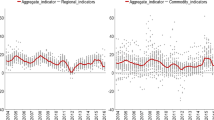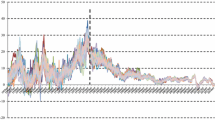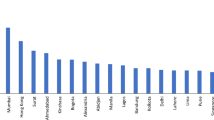Abstract
This paper aims to identify convergence clubs in regional price across 34 provinces in Indonesia and investigate conditioning factors of club formation. We analyze regional monthly consumer price data from January 2012 to December 2019 with a novel club convergence test developed by Phillips and Sul (Econometerica 756:1771–1855, 2007), and show that regional consumer price does not converge into a single universal equilibrium. Instead, there are four convergence clubs identified. Further investigation shows that labor productivity, inflation expectation, consumption growth, and spatial externalities influence the convergence club formation. From a policy perspective, our findings of multiple convergence clubs and their influencing factors alert policy makers to rethink the possibility of augmenting uniform monetary policy with region-specific inflation management measures.




Similar content being viewed by others
Availability of data and material
Available upon request.
Notes
The paper studies convergence in three efficiency measures: overall efficiency, pure efficiency, and scale efficiency. Although the paper finds regional convergence in efficiency according to the classical convergence framework results, the paper also reports the existence of two local convergence clusters in overall and pure efficiency distributions based on the results from the distributional convergence approach. Finally, the paper emphasizes that two clusters of pure efficiency are the main drivers of Indonesia’s overall regional efficiency dynamics. This is also consistent with the standard consensus in the context of growth literature, where the distribution of income per capita across economies exhibits clustering patterns rather than a common growth path. For a comprehensive survey of the convergence literature, see Islam (2003).
Testing convergence using Consumer Price Index (CPI) may lead to misleading results due to the base year problem in CPI construction that affects the first observation. To overcome this problem, we followed the suggestion of Phillips and Sul (2007) and applied \(r\) = 0.33. This means that the first 33% of our observation is discarded and thus the log t regression model focuses attention on the latter part of the sample data.
The detailed procedure of club merging test is provided in Appendix 2.
While π is the average annual inflation (%, yoy) of all provinces in each club from 2013 to 2019, \(\hat{\alpha }\) is the convergence rate defined from Eq. (8) as \(\hat{b}\) /2.
As described by Samuelson (1994), the Penn effect emphasizes the positive relationship between productivity and the price levels, while the Balassa–Samuelson effect points to the differences in productivity between tradable and non-tradable sectors that describe inflation differential between countries/regions.
We imputed missing values for the data of the number of employed people in North Kalimantan province to compute labor productivity as defined in Table 3. Details on this imputation process are provided in Appendix 3.
All explanatory variables used in the ordered logit model are measured as the mean values during the 2012-2019 period. We performed ordered logit regression using the command ologit in Stata.
Note that since the sum of probabilities for all four clubs must equal one, the partial derivatives across the clubs are equal to zero.
References
Affandi Y (2011) Unveiling stubborn inflation in Indonesia. Ekonomi Dan Keuang Indones 59(1):47
Aginta H, Gunawan AB, Mendez C (2020) Regional income disparities and convergence clubs in Indonesia: new district-level evidence 2000–2017. University Library of Munich, Germany
Alamsyah H, Joseph C, Agung J, Zulverdy D (2001) Towards implementation of inflation targeting in Indonesia. Bull Indones Econ Stud 37(3):309–324
Azariadis C, Drazen A (1990) Threshold externalities in economic development. Q J Econ 105(2):501–526. https://doi.org/10.2307/2937797(JSTOR)
Barro RJ, Sala-i-Martin X, Blanchard OJ, Hall RE (1991) Convergence across states and regions. Brook Papers Econ Activ 1991(1):107–182. https://doi.org/10.2307/2534639
Bartkowska M, Riedl A (2012) Regional convergence clubs in Europe: identification and conditioning factors. Econ Model 29(1):22–31
Beck GW, Hubrich K, Marcellino M (2009) Regional inflation dynamics within and across euro area countries and a comparison with the United States. Econ Policy 24(57):142–184
Blanco F, Martin V, Vazquez G (2016) Regional house price convergence in Spain during the housing boom. Urban Stud 53(4):775–798
Brodjonegoro BP, Falianty T, Gitaharie BY et al (2005) Determinant factors of regional inflation in decentralized Indonesia. J Econ Finance Indones 53(1):1–31
Cecchetti SG, Mark NC, Sonora RJ (2000) Price level convergence among United States cities: lessons for the European Central Bank. NBER Working Papers. National Bureau of Economic Research, Inc, 7681
Christou C, Cunado J, Gupta R (2018) Price convergence patterns across U.S. States. Panoeconomicus 66(2). https://doi.org/10.2298/pan160625008c. http://panoeconomicus.org/index.php/jorunal/article/view/408
De Grauwe P (1996) Monetary union and convergence economics. Eur Econ Rev 40(3–5):1091–1101
Du K (2017) Econometric convergence test and club clustering using stata. Stata J 17(4):882–900. https://doi.org/10.1177/1536867X1801700407
Evans P, Karras G (1996) Convergence revisited. J Monet Econ 37(2):249–265. https://doi.org/10.1016/S0304-3932(96)90036-7
Fan CS, Wei X (2006) The law of one price: evidence from the transitional economy of China. Rev Econ Stat 88(4):682–697. https://doi.org/10.1162/rest.88.4.682
Galor O (1996) Convergence? Inferences from theoretical models. Econ J 106(437):1056–1069. https://doi.org/10.2307/2235378(JSTOR)
Gluschenko K (2005) Inter-regional price convergence and market integration in Russia. Int Adv Econ Res 11(4):483
Hotelling H (1933) Review of the triumph of mediocrity in business by Horace Secrist. J Am Stat Assoc 28(184):463–465. https://doi.org/10.2307/2278144(JSTOR)
Islam N (2003) What have we learnt from the convergence debate? J Econ Surv 17:309–362. https://doi.org/10.1111/1467-6419.00197
Jangam BP, Akram V (2019) Do prices converge among Indonesian cities? An empirical analysis. Bull Monet Econ Bank 22(3):239–262
Johnson PA (2020) Parameter variation in the “log t” convergence test. Appl Econ Lett 27(9):736–739. https://doi.org/10.1080/13504851.2019.1644436
Kim YS, Rous JJ (2012) House price convergence: evidence from US state and metropolitan area panels. J Hous Econ 21(2):169–186
Marques H, Pino G, de Horrillo JDT (2014) Regional inflation dynamics using space–time models. Empir Econ 47(3):1147–1172
McKelvey RD, Zavoina W (1975) A statistical model for the analysis of ordinal level dependent variables. J Math Sociol 4(1):103–120
Mendez C (2020) Regional efficiency convergence and efficiency clusters. Asia-Pac J Reg Sci. https://doi.org/10.1007/s41685-020-00144-w
Mendez C, Kataoka M (2020) Disparities in regional productivity, capital accumulation, and efficiency across Indonesia: a club convergence approach. Rev Dev Econ 1– 20. https://doi.org/10.1111/rode.12726
Moon S (2017) Inter-region relative price convergence in Korea. East Asian Econ Rev 21(2):123–146
Nagayasu J (2017) Regional inflation, spatial locations and the Balassa–Samuelson effect: evidence from Japan. Urban Stud 54(6):1482–1499
Phillips PCB, Sul D (2007) Transition modelling and econometric convergence tests. Econometerica 75(6):1771–1855
Phillips PCB, Sul D (2009) Economic transition and growth. J Appl Econ 24(7):1153–1185. https://doi.org/10.1002/jae.1080
Purwono R, Yasin MZ, Mubin MK (2020) Explaining regional inflation programmes in Indonesia: does inflation rate converge? Econ Change Restruct 53:571–590. https://doi.org/10.1007/s10644-020-09264-x
Quah DT (1996) Regional convergence clusters across Europe. Eur Econ Rev 40(3–5):951–958
Rogers JH (2007) Monetary union, price level convergence, and inflation: how close is Europe to the USA? J Monet Econ 54(3):785–796. https://doi.org/10.1016/j.jmoneco.2006.01.004
Rogoff K (1996) The purchasing power parity puzzle. J Econ Literature 34(2):647–668
Samuelson PA (1994) Facets of Balassa–Samuelson thirty years later. Rev Int Econ 2(3):201–226
Sichera R, Pizzuto P (2019) ConvergenceClubs: a package for performing the Phillips and Sul’s club convergence clustering procedure. R J 11(2). https://journal.r-project.org/archive/2019/RJ-2019-021/RJ-2019-021.pdf
Sonora RJ (2005) City CPI convergence in Mexico. Rev Dev Econ 9(3):359–367. https://doi.org/10.1111/j.1467-9361.2005.00281.x
Tirtosuharto D, Adiwilaga H (2013) Decentralization and regional inflation in Indonesia. Bul Ekon Monet Dan Perbank 16(2):137–154
Von Lyncker K, Thoennessen R (2017) Regional club convergence in the EU: evidence from a panel data analysis. Empir Econ 52(2):525–553
Wimanda RE (2009) Price variability and price convergence: evidence from Indonesia. J Asian Econ 20(4):427–442. https://doi.org/10.1016/j.asieco.2009.06.002
Wimanda RE, Turner PM, Hall MJ (2011) Expectations and the inertia of inflation: the case of Indonesia. J Policy Model 33(3):426–438
Funding
Not applicable.
Author information
Authors and Affiliations
Corresponding author
Ethics declarations
Conflict of interest
The author(s) declare that they have no competing interests.
Code availability
Available upon request.
Additional information
Publisher's Note
Springer Nature remains neutral with regard to jurisdictional claims in published maps and institutional affiliations.
Appendix
Appendix
1.1 Appendix 1: Club-clustering algorithm
Although the null hypothesis of overall convergence (\(H_{0} )\) tested using log t regression is rejected, it does not necessarily mean that the convergence in the sub-sample of the panel is not present. To identify the presence these convergence clubs, Phillips and Sul (2007) developed a club-clustering algorithm. In brief, the implementation of the club-clustering algorithm within the scope of our study involves the following four steps (a detailed description of the procedure in club clustering is given in Phillips and Sul (2007)):
-
Step 1: Cross-section ordering.
Sample units (provinces) are arranged in a decreasing order according to their value (CPI) in the last period (December 2019).
-
Step 2: Constructing the core group.
A core group of sample units (provinces) is identified by conducting the log t test for the first k = 2 provinces. If the null hypothesis of convergence (\(H_{0} )\) is not rejected, that is \(t_{{\hat{b}}}\) (k = 2) > \(-\) 1.65, both provinces assemble the core group \(G_{k} .\) This procedure is implemented sequentially for \(G_{k}\) + the next province as long as \(t_{{\hat{b}}}\) (k) > \(t_{{\hat{b}}}\) (k \(-\) 1). Thus, if \(t_{{\hat{b}}}\) (k = 3) > \(t_{{\hat{b}}}\) (k = 2), the last province is added to the core group \(G_{k}\).
-
Step 3: Deciding club membership.
After the core group \(G_{k}\) is constructed, log t test is implemented on \(G_{k}\) with each subsequent unit (province) according to the decreasing order established in Step 1. Sample units (provinces) not belonging to the core group \(G_{k}\) are re-evaluated one at a time with log t regression in Eq. (8). If the test strongly supports the convergence hypothesis (log t \(\ge\) 0), all those units (provinces) are added to the core group \(G_{k}\), forming the first convergence club in the panel.
-
Step 4: Iteration and stopping rule.
Step 1–3 are applied for the remaining sample units (provinces), if any, to determine the next convergence club. If the process shows the rejection of null hypothesis of convergence (\(H_{0} )\), the procedure is terminated. In this case, the remaining sample units (provinces) are labeled as divergent if no core group is found, and the algorithm stops.
1.2 Appendix 2: Test for clubs merging
To evaluate whether the clubs identified according to the clustering algorithm described in Sect. 3.2 and “Appendix 1” can be merged, in this study, we use a “club merging algorithm” by Phillips and Sul (2009). By testing for merging between adjacent clubs, the procedure works as follows: first, apply log t test on the first two initial groups identified in the clustering mechanism. If the t-statistic > − 1.65, these two groups together form a new convergence club. Second, repeat the first step by adding the next club. Continue this process until the condition of t-statistic > − 1.65 is achieved. Third, if convergence hypothesis is rejected, that is when t-statistic > − 1.65 does not hold, we assume that all previous groups converge, except the last added one. Hence, we restart the merging algorithm from the club for which the hypothesis of convergence does not hold.
1.3 Appendix 3: Data imputation for missing values on number of employed people for North Kalimantan province, 2012–2014
As defined in Table 3, we computed labor productivity by dividing Gross Regional Domestic Product (constant price 2010)/number of people employed in each province. Indonesian Central Bureau of Statistics publishes data of number of people employed based on National Labour Force Survey (Sakernas). The survey is specifically designed to collect information on labor force statistics.
As a new proliferated province in 2013 from the main province of East Kalimantan, series of number of people employed in North Kalimantan province is available only from the year of 2015. Before that year, the series for North Kalimantan province is combined the series for East Kalimantan province. Thus, we faced the problem of missing values of number of people employed series for North Kalimantan province for three observations; 2012, 2013 and 2014. We implemented two following steps to solve this missing values problem. First, we conducted imputation by using linear regression method with the reference province and year as regressors. East Kalimantan province (the origin province) is chosen as reference for imputation, implying the assumption of co-movements between these two provinces. Second, we subtracted the values of original data for East Kalimantan province in the year of 2012, 2013 and 2014 with the imputed values for North Kalimantan province and used these subtracted values as final series for East Kalimantan province. Figure 5 compares number of people employed series in East Kalimantan and North Kalimantan province before and after imputation process.
About this article
Cite this article
Aginta, H. Spatial dynamics of consumer price in Indonesia: convergence clubs and conditioning factors. Asia-Pac J Reg Sci 5, 427–451 (2021). https://doi.org/10.1007/s41685-020-00178-0
Received:
Accepted:
Published:
Issue Date:
DOI: https://doi.org/10.1007/s41685-020-00178-0





